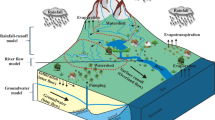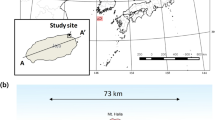Abstract
In this study, the applicability of the composite model for assessing seawater intrusion and soil salinization in coastal aquifers due to climate change was investigated. In this approach, flow in the saturated zone of a coastal aquifer is simulated using a three-dimensional saturated–unsaturated transport model and flow in the unsaturated zone between the surface and groundwater level is simulated using a one-dimensional model in the vertical direction. Long-term sea-level predictions obtained using the representative concentration pathway (RCP) 4.5 and 8.5 scenarios were applied for computing the sea-level rise for 91 country-managed reclaimed areas in the Republic of Korea. Composite results were obtained and analyzed for seawater intrusion and soil salinization due to sea-level rise. In the results of groundwater and soil salinity in all 91 reclaimed land, the increasing rate of groundwater and soil salinity in the RCP 4.5 scenario was 13.5% and 10.4%, respectively. In the RCP 8.5 scenario, the increasing rate of groundwater and soil salinity was 14.1% and 11.1%, respectively. The groundwater level increased to 0.41 m in the RCP 4.5 scenario and 0.51 m in the RCP 8.5 scenario. The results for two representative reclaimed land areas in the Heungwang and Deokchon districts were examined in detail. The composite analysis revealed that widespread damage could be caused by sea-level rise in the reclaimed land and that seawater intrusion in many regions will accelerate groundwater salinization over time. Moreover, the reclaimed land areas were characterized in terms of watershed size, presence of ponds, water levels of the ponds, and pond locations. In reclaimed land located in small watersheds, the groundwater recharge area was smaller than in land located in larger watershed areas. Consequently, the seawater in small watersheds penetrated further inland. Ponds with water levels higher than the sea level effectively prevented seawater intrusion into groundwater. If the water level of a pond is similar to or lower than the sea level, it indicates that seawater has already penetrated a large part of the aquifer. The composite model developed in this study seems to be one of the simulation methods that can be applied when simulating saturated and unsaturated zone to a large number of sites. Also, the study results could be used to establish and implement a long-term comprehensive plan for water resources at the national level, considering seawater intrusion due to climate change and providing a basis for establishing countermeasures against future seawater intrusion.












Similar content being viewed by others
References
Carretero, S., Rapaglia, J., Bokuniewicz, H., Kruse, E.: Impact of sea-level rise on saltwater intrusion length into the coastal aquifer, Partido de La Costa. Argentina. Cont. Shelf Res. 61–62, 62–70 (2013). https://doi.org/10.1016/j.csr.2013.04.029
Chang, S.W., Clement, T.P., Sim Dattapson, M.J., Lee, K.K.: Does sea-level rise have an impact on saltwater intrusion? Adv. Water Resour. 34, 1283–1291 (2011). https://doi.org/10.1016/j.advwatres.2011.06.006
Chen, W., Chen, K., Kuang, C., Zhu, D.Z., He, L., Mao, X., Liang, H., Song, H.: Influence of sea level rise on saline water intrusion in the Yangtze River Estuary. China. Appl. Ocean Res. 54, 12–25 (2016). https://doi.org/10.1016/j.apor.2015.11.002
De Louw, P.G.B., Oude Essink, G.H.P., Stuyfzand, P.J., van der Zee, S.E.A.T.M.: Upward groundwater flow in boils as the dominant mechanism of salinization in deep polders, The Netherlands. J. Hydrol. 394, 494–506 (2010). https://doi.org/10.1016/j.jhydrol.2010.10.009
Dehaan, R.L., Taylor, G.R.: Field-derived spectra of salinized soils and vegetation as indicators of irrigation-induced soil salinization. Remote Sens. Environ. 80, 406–417 (2002). https://doi.org/10.1016/S0034-4257(01)00321-2
Dogan, A., Motz, L.H.: Saturated-Unsaturated 3D groundwater model. I: development. J. Hydrol. Eng. (2005). https://doi.org/10.1061/(ASCE)1084-0699(2005)10:6(492)
Dunlop, G., Palanichamy, J., Kokkat, A., James, E.J., Palani, S.: Simulation of saltwater intrusion into coastal aquifer of Nagapattinam in the lower cauvery basin using SEAWAT. Groundw. Sustain. Dev. 8, 294–301 (2019). https://doi.org/10.1016/j.gsd.2018.11.014
Farifteh, J., Farshad, A., George, R.J.: Assessing salt-affected soils using remote sensing, solute modelling, and geophysics. Geoderma 130, 191–206 (2006). https://doi.org/10.1016/j.geoderma.2005.02.003
Farthing, M.W., Ogden, F.L.: Numerical solution of Richards’ equation: a review of advances and challenges. Soil Sci. Soc. Am. J. 81, 1257–1269 (2017). https://doi.org/10.2136/sssaj2017.02.0058
Ferguson, G., Gleeson, T.: Vulnerability of coastal aquifers to groundwater use and climate change. Nat. Clim. Change 2, 342–345 (2012). https://doi.org/10.1038/nclimate1413
Freeze, R.A.: Three dimensional, transient, saturated-unsaturated flow in a groundwater basin. Water Resour. Res. 7, 347–366 (1971). https://doi.org/10.1029/WR007i002p00347
Gao, Y., Pu, S., Zheng, C., Yi, S.: An improved method for the calculation of unsaturated–saturated water flow by coupling the FEM and FDM. Sci. Rep. 9, 1–9 (2019). https://doi.org/10.1038/s41598-019-51405-4
Gopinath, S., Srinivasamoorthy, K., Saravanan, K., Suma, C.S., Prakash, R., Senthilnathan, D., Chandrasekaran, N., Srinivas, Y., Sarma, V.S.: Modeling saline water intrusion in Nagapattinam coastal aquifers, Tamilnadu, India. Model. Earth Syst. Environ. 2, 1–10 (2016). https://doi.org/10.1007/s40808-015-0058-6
Huyakorn, P.S., Buckley, J.E.: VADOFT: finite element code for simulating one-dimensional flow and solute transport in the vadose-zone (1987)
IPCC: Climate Change 2014: Synthesis report. Contribution of Working Groups I, II and III to the Fifth Assessment Report of the Intergovernmental Panel on Climate Change [Core Writing Team, R.K. Pachauri and L.A. Meyer (eds.)]. IPCC, pp. 151. Geneva, Switzerland (2014)
Jung, E., Cho, K., Park, N.: Composite model for seawater intrusion in groundwater and soil salinization due to sea level rise. J. Korea Water Resour. Assoc. 50, 387–395 (2017). https://doi.org/10.3741/jkwra.2017.50.6.387
KHOA: Research Report on Development of Korean Sea Level Change Analysis. Korea Hydrographic and Oceanographic Administration, Busan, Republic of Korea (2014)
Kitamura, Y., Yano, T., Honna, T., Yamamoto, S., Inosako, K.: Causes of farmland salinization and remedial measures in the Aral Sea basin-Research on water management to prevent secondary salinization in rice-based cropping system in arid land. Agric. Water Manag. 85, 1–14 (2006). https://doi.org/10.1016/j.agwat.2006.03.007
KRCC: Seawater Intrusion Investigation Report. Korea Rural Community Corporation, Naju, Republic of Korea (2018)
List, F., Radu, F.A.: A study on iterative methods for solving Richards’ equation. Comput. Geosci. 20, 341–353 (2016). https://doi.org/10.1007/s10596-016-9566-3
Loáiciga, H.A., Pingel, T.J., Garcia, E.S.: Sea water intrusion by sea-level rise: scenarios for the 21st century. Ground Water 50, 37–47 (2012). https://doi.org/10.1111/j.1745-6584.2011.00800.x
Masciopinto, C., Liso, I.S.: Assessment of the impact of sea-level rise due to climate change on coastal groundwater discharge. Sci. Total Environ. 569–570, 672–680 (2016). https://doi.org/10.1016/j.scitotenv.2016.06.183
Metternicht, G.I., Zinck, J.A.: Remote sensing of soil salinity: potentials and constraints. Remote Sens. Environ. 85, 1–20 (2003). https://doi.org/10.1016/S0034-4257(02)00188-8
MOLIT: 3rd Revised Plan of Water Resources Long-Term Comprehensive Plan (2001–2020). Ministry of Land, Infrastructure and Transport, Sejong, Republic of Korea (2016a)
MOLIT: Revised Basic Plan for Groundwater Management Plan (2017–2026). Ministry of Land, Infrastructure and Transport, Sejong, Republic of Korea (2016b)
Narayan, K.A., Schleeberger, C., Bristow, K.L.: Modelling seawater intrusion in the Burdekin Delta Irrigation Area, North Queensland, Australia. Agric. Water Manag. 89, 217–228 (2007). https://doi.org/10.1016/j.agwat.2007.01.008
NGWA: Brackish Groundwater. National Ground Water Association, Westerville (2014)
Oh, Y.-J., Kim, M.-H., Na, Y.-E., Hong, S.-H., Paik, W.-K., Yoon, S.-T.: Vulnerability assessment of soil loss in farm area to climate change adaption. Korean J. Soil Sci. Fertil. 45, 711–716 (2012). https://doi.org/10.7745/kjssf.2012.45.5.711
Oude Essink, G.H.P., Van Baaren, E.S., De Louw, P.G.B.: Effects of climate change on coastal groundwater systems: a modeling study in the Netherlands. Water Resour. Res. 46, 1–16 (2010). https://doi.org/10.1029/2009WR008719
Oude Essink, G.H.P.: Salt water intrusion in a three-dimensional groundwater system in The Netherlands : a numerical study. Transp. Porous Media. 137–158 (2001)
Paniconi, C., Khlaifi, I., Lecca, G., Giacomelli, A., Tarhouni, J.: Modeling and analysis of seawater intrusion in the coastal aquifer of Eastern Cap-Bon, Tunisia. Transp. Porous Media 43, 3–28 (2001). https://doi.org/10.1023/A:1010600921912
Pool, M., Carrera, J.: Dynamique des barrières hydrauliques nègatives pour prèvenir ĺintrusion d́eau de mer. Hydrogeol. J. 18, 95–105 (2010). https://doi.org/10.1007/s10040-009-0516-1
RDA: Look into The Reclaimed Land Soil Characteristics. Rural Development Administration, Jeonju, Republic of Korea (2013)
Roy, D. K., Datta, B.: Influence of sea level rise on multiobjective management of saltwater intrusion in coastal aquifers. J. Hydrol. Eng. 23, (2018). https://doi.org/10.1061/(ASCE)HE.1943-5584.0001680
Sherif, M.M., Hamza, K.I.: Mitigation of seawater intrusion by pumping brackish water. Transp. Porous Media 43, 29–44 (2001). https://doi.org/10.1023/A:1010601208708
Sherif, M.M., Singh, V.P.: Effect of climate change on sea water intrusion in coastal aquifers. Hydrol. Process. 13, 1277–1287 (1999). https://doi.org/10.1002/(SICI)1099-1085(19990615)13:8%3c1277:AID-HYP765%3e3.0.CO;2-W
U.S. Salinity Laboratory: Diagnosis and Improvement of Saline and Alkali Soils. Washington, DC (1954)
USEPA: PRZM-2. A Model for Predicting Pesticide Fate in The Crop Root and Unsaturated Soil Zones. User Manual for Release 2.0. U.S. Environmental Protection Agency, Athens (1993)
Van Duijn, C.J., Schotting, R.J.: The interface between fresh and salt groundwater in horizontal aquifers: the Dupuit–Forchheimer approximation revisited. Transp. Porous Media 117, 481–505 (2017). https://doi.org/10.1007/s11242-017-0843-y
Van Genuchten, M.T.: Closed-form equation for predicting the hydraulic conductivity of unsaturated soils. Soil Sci. Soc. Am. J. 44, 892–898 (1980). https://doi.org/10.2136/sssaj1980.03615995004400050002x
Vinsome, P.K.W.: Orthomin, an iterative method for solving sparse sets of simultaneous linear equations. Society of Petroleum Engineers. Society of Petroleum Engineers, Richardson (1976). https://doi.org/10.2118/5729-MS
Voss, C.: A finite-element simulation model for saturated-unsaturated, fluid-density-dependent groundwater flow with energy transport or chemically-reactive single-species solute transport. U.S. Geol. Surv. 409 (1984)
Vu, D.T., Yamada, T., Ishidaira, H.: Assessing the impact of sea level rise due to climate change on seawater intrusion in Mekong Delta, Vietnam. Water Sci. Technol. 77, 1632–1639 (2018). https://doi.org/10.2166/wst.2018.038
Wassef, R., Schüttrumpf, H.: Impact of sea-level rise on groundwater salinity at the development area western delta, Egypt. Groundw. Sustain. Dev. 2–3, 85–103 (2016). https://doi.org/10.1016/j.gsd.2016.06.001
Werner, A.D., Simmons, C.T.: Impact of sea-level rise on sea water intrusion in coastal aquifers. Ground Water 47, 197–204 (2009). https://doi.org/10.1111/j.1745-6584.2008.00535.x
Xiao, H., Wang, D., Medeiros, S.C., Hagen, S.C., Hall, C.R.: Assessing sea-level rise impact on saltwater intrusion into the root zone of a geo-typical area in coastal east-central Florida. Sci. Total Environ. 630, 211–221 (2018). https://doi.org/10.1016/j.scitotenv.2018.02.184
Acknowledgements
This research was supported by the APEC Climate Center and the Korea Environment Industry & Technology Institute (KEITI) through the Advanced Water Management Research (AWMP) Program, funded by the Korean Ministry of Environment (MOE) (83076).
Author information
Authors and Affiliations
Corresponding author
Additional information
Publisher's Note
Springer Nature remains neutral with regard to jurisdictional claims in published maps and institutional affiliations.
Rights and permissions
About this article
Cite this article
Jung, E., Park, N. & Park, J. Composite Modeling for Evaluation of Groundwater and Soil Salinization on the Multiple Reclaimed Land Due to Sea-Level Rise. Transp Porous Med 136, 271–293 (2021). https://doi.org/10.1007/s11242-020-01511-z
Received:
Accepted:
Published:
Issue Date:
DOI: https://doi.org/10.1007/s11242-020-01511-z




